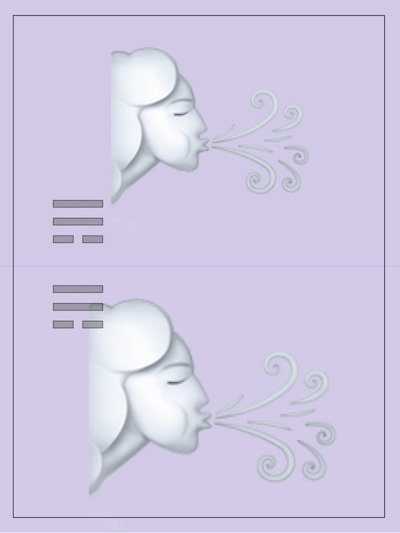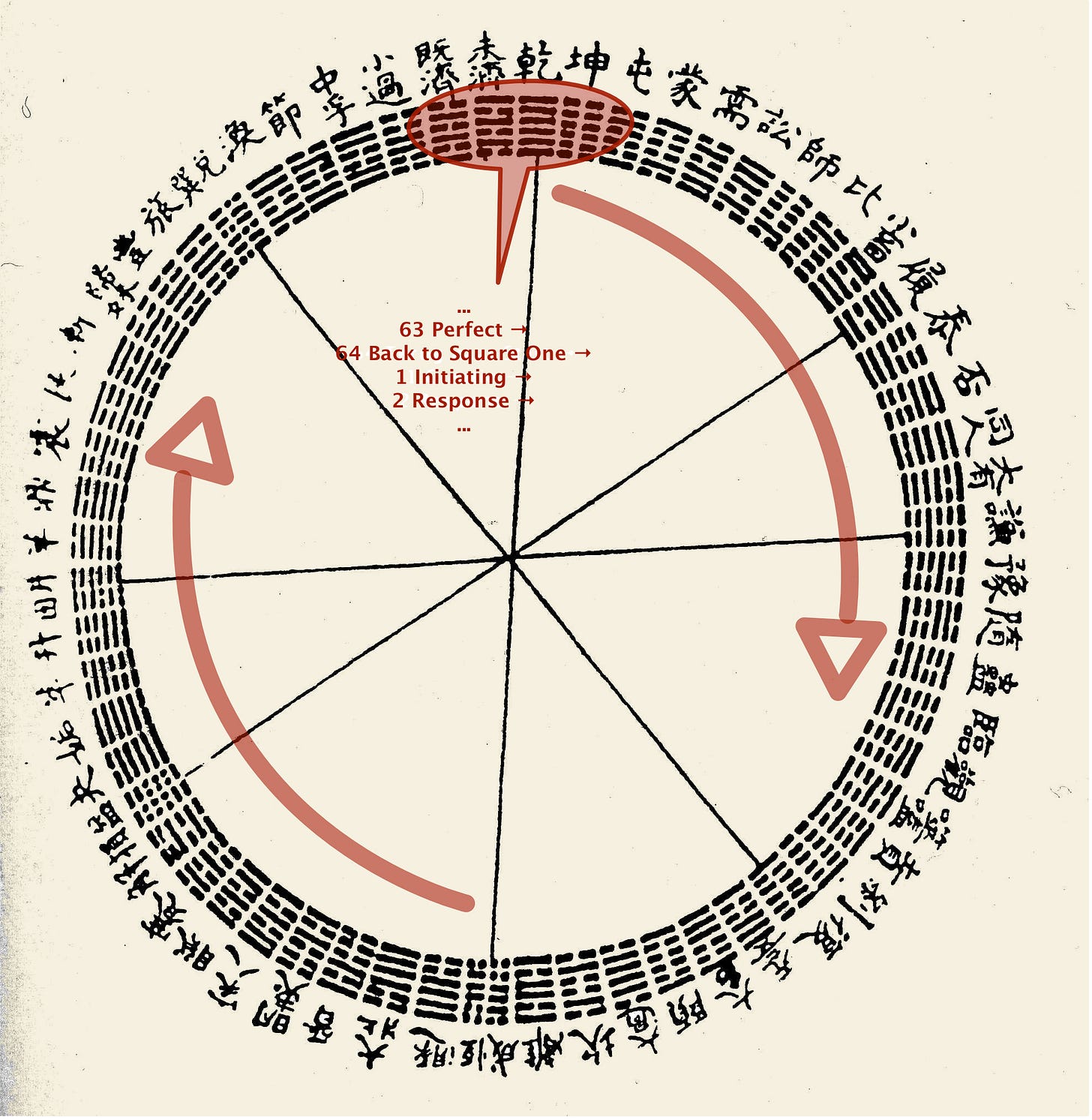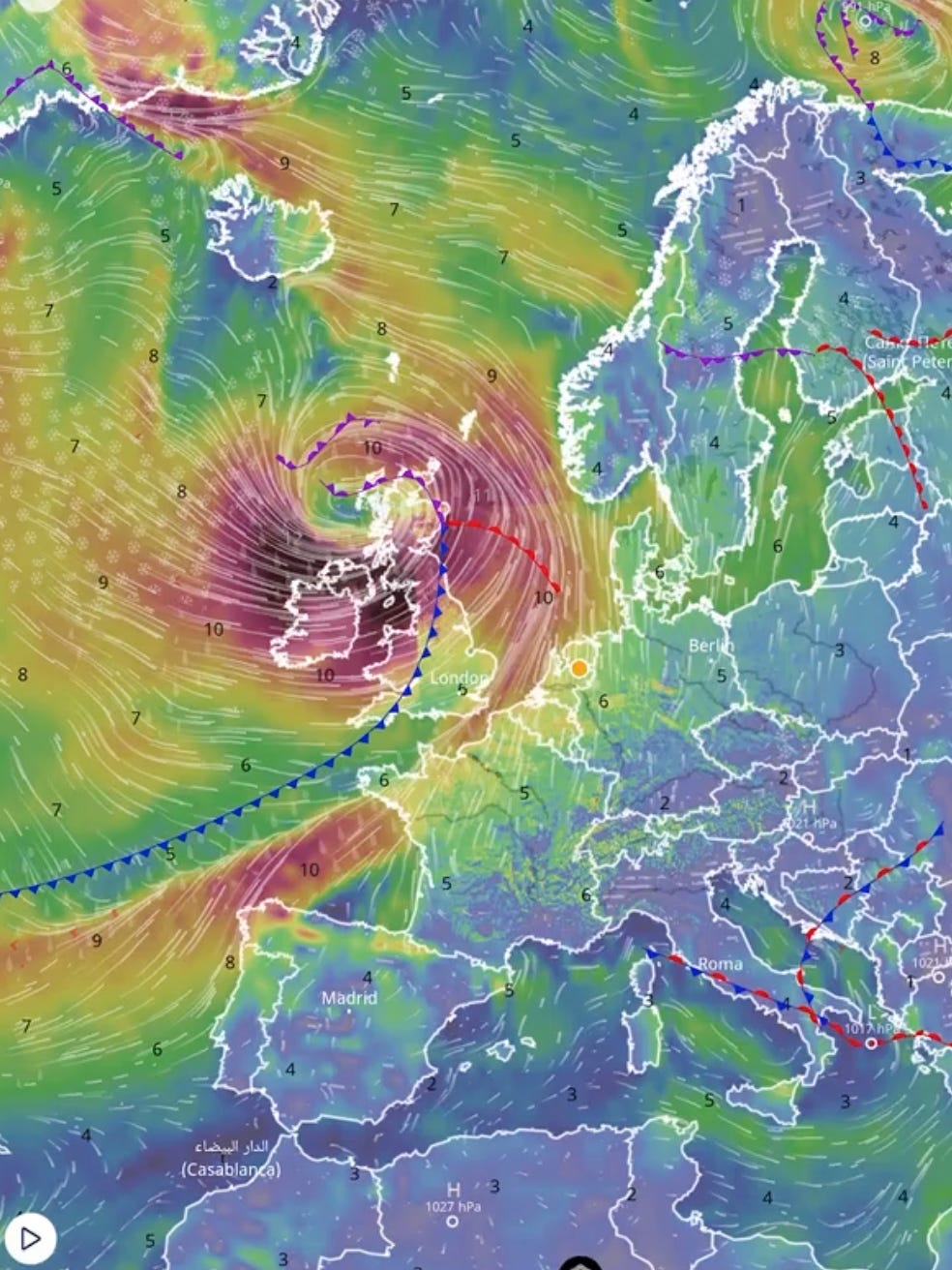THE IMAGE: twice the trigram of the Wind. A doubling of the wind. Is the book referring here to a summer breeze that grows into a gale force wind? Or is 'Wind below and Wind above' a sketch of the winds blowing close over the earth's surface and those blowing high in the atmosphere? Or does the book want the doubling to emphasise one or more of the characteristics of wind: gentleness, penetrating power, making connections or the ability to disperse?
All chapters of the I Ching describe change. Nothing remains as it is and no chapter notes the achievement of the ultimate, the perfect humanity or the fulfilment of an ideal society. The pendulum seeks balance, but as soon as it is found, it shoots on to the next extreme, lingers silently in a vacuum for a moment, and reverses its movement. Transition, transformation, alternation, changement, reversal, variation, evolution, revolution, adaptation, adjustment, improvement, correction, reversal, alternation, inversion, mirroring, twisting, metamorphosis, modification, alteration, reformation, counter-reformation, camouflage, assimilation, transmutation, emergence. Am I missing any manifestation of change?
In the beginning there was an idea, a flash, a creative spark - and as soon as it resonated, an unstoppable sequence of mutation and change followed. For the spark and the resonance, see Chapter 1. Creation and Chapter 2. Response. And then follow 60 chapters full of shapeshifting, reversals and mirroring.
Imagine if the Book of Change ended with Utopia. No more discord is heard. Opposites have embraced each other. All six lines are in the right place. At the bottom, the first place of the hexagram is a yang line - like an initial impetus, a starting shot. Followed by a yin line, the imagination of the right response. Above that, another yang line: a restart. Followed by yin, a new rest pose. Another yang on the fifth spot and finally, as a final note, a yin line. Action-response, action-response, action-response. The perfect variety of things. There is nothing left to wish for. Seventh heaven.
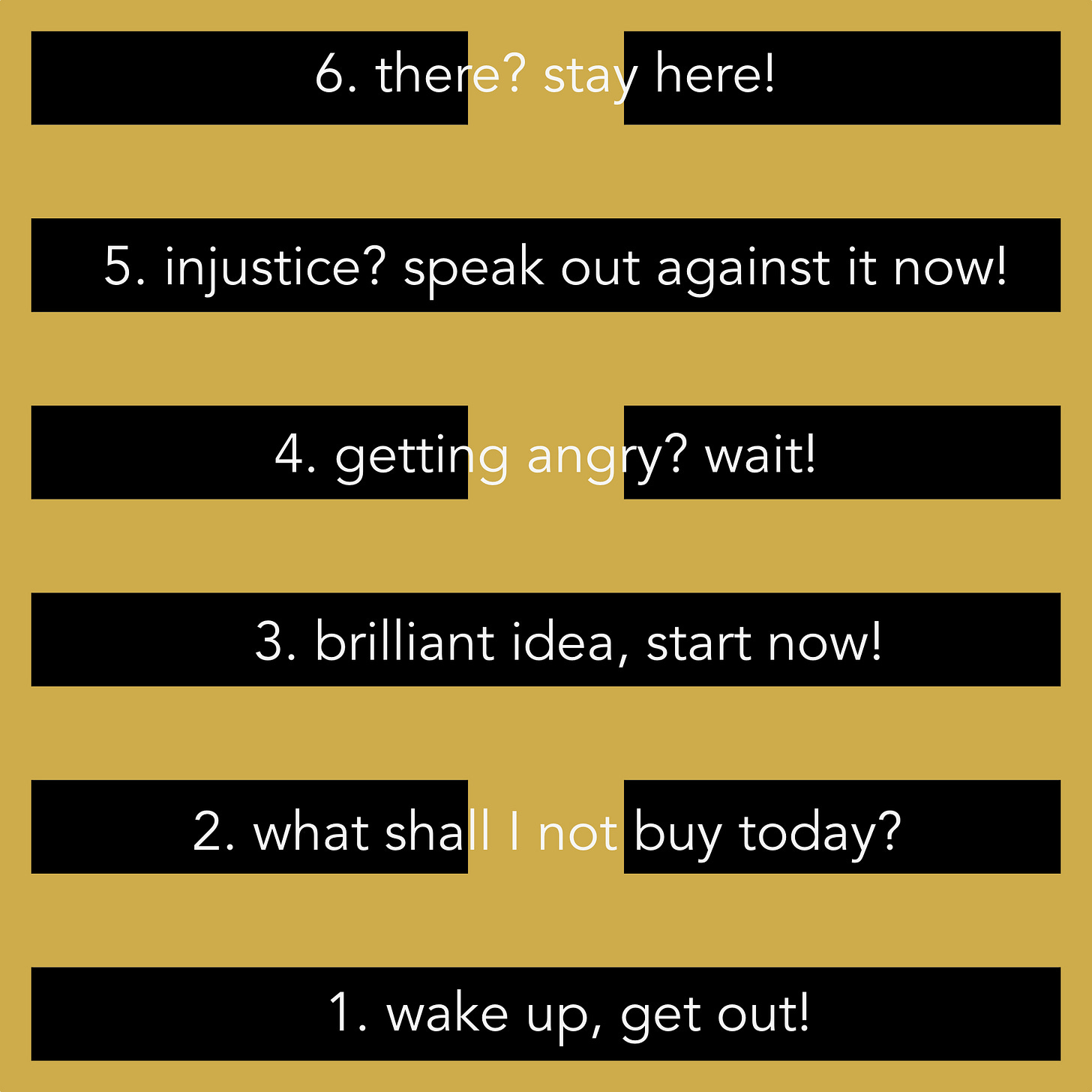
But the above is not the description of the concluding chapter, No 64 - it is that of the penultimate, No 63. Perfect. All lines have been filled in according to their destination. The piece of music has finally found its keynote after countless modulations and wanderings. The prodigal son has returned. All's well that ends well. You wished! Suddenly there is great dissonance. The harmonious grand finale is disrupted. The hope of a safe homecoming, this time forever, turns out to be an illusion. All six strings are out of tune. Not much, but that only makes the falseness more poignant. The devil is in the tail: after the glory of Chapter 63 comes 64. Back to Square One. And you won't receive €200.
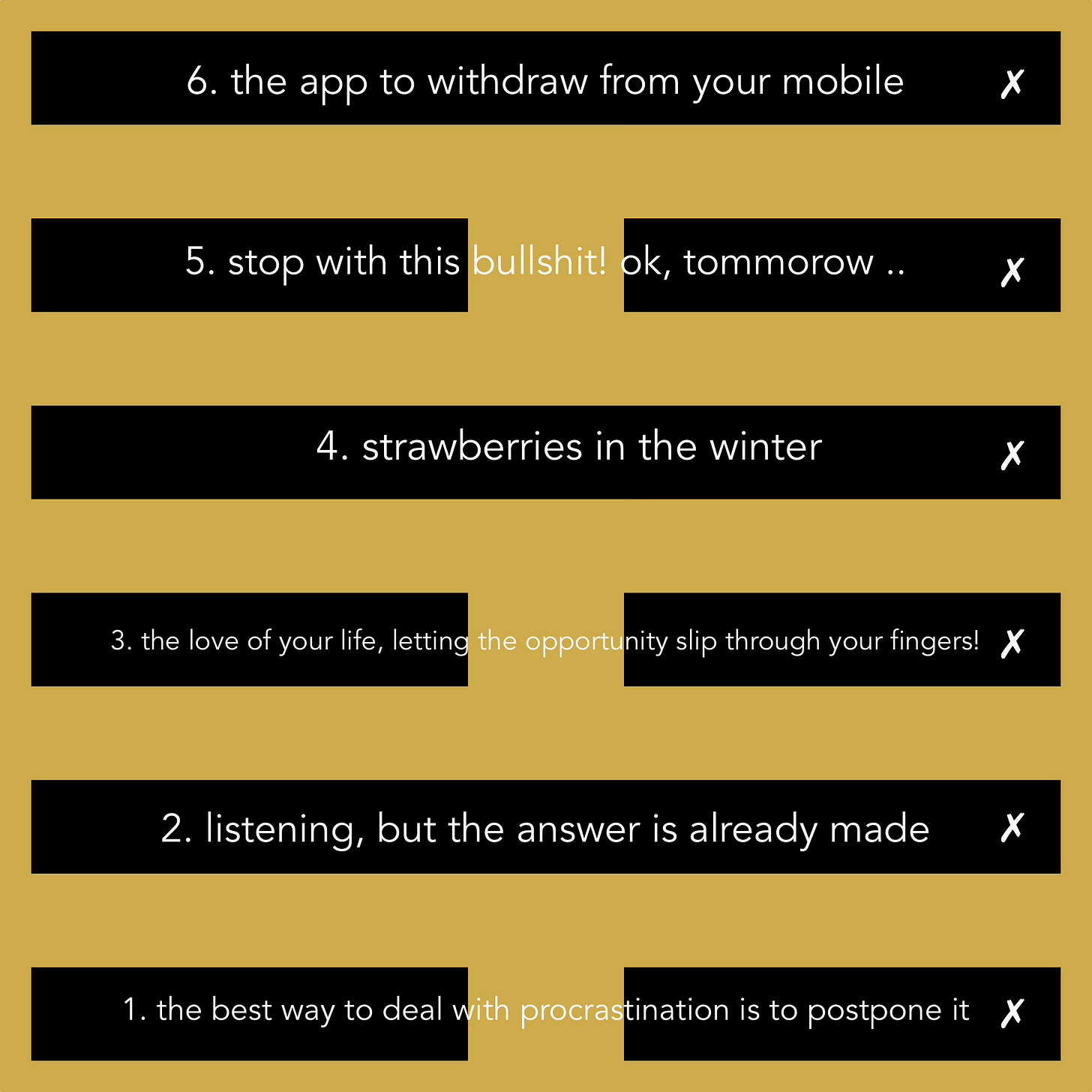
The first place of the hexagram, at the very bottom - depicting a fresh start - is occupied by a passive yin line. I got a brilliant idea, but forgot to make a note and now it has disappeared. A prime opportunity passed me by. Missed the starting shot, not having my head in the game.
The second spot is for response, but there is a yang line right there. Rest is called for recovery and to come to understanding. But instead of rest, there is noisy entertainment and time is filled with empty entertainment. All six places of the hexagram are filled opposite to their nature. Not in one, not in two, in all places there is a false tone. An art in itself. ‘Not only the wrong planet, you got the wrong solar system!’
... until finally all places are filled in a way that is cursory to what is really required.
In chapter 64, the circle of successive change closes: Back to Square One. There is no other choice than to start all over again. Once more the spark between the two archetypes of the 'Idea' and the 'Response' and the wheel of change starts turning again. Nothing happy ending, life goes on inexorably.
If there is a chapter that best depicts the phenomenon of change, it might be 57. Wind. Wind brings the excess to places where there is shortage. The wind disperses and thins. A first wind of spring or a lull before the storm announce change. Without a headwind no growth and without a back wind no hope. Imagine a windless nature. No pollination and no spreading. No smell, no cooling. No rain, no seasons. The wind of change. And for those who thought it would stop at a south westerly and easterly wind with jellyfish:
Aeolus, the Greek god of wind. Ephrachis, the Roman god of the southwest wind. Ammonet, the Egyptian goddess of north wind slash childbearing. Anzu, the Sumerian god of the southwest wind and thunder. Kilo, the Roman god of the north wind. Hara Tio Tio, the Polynesian god of tornadoes. Pora, the Greek goddess of the morning wind. Auster, the Roman god of south wind. Ace, the Armenian demon who embodies the wind. Bacchus, Mayan god of the four winds. Aureus, the Greek god of north wind. Breath of winds, Iroquois god of winds. Bucca, Finnish goblin of the wind. Beluga, Aboriginal god of wind. Chao, Mayan god of lightning, rain, thunder, and wind. Qipao, the Chinese god of wind. Chou, the Chumash goddess of wind and rain. Khomboi, Coat tree sheep, Uribian goddess of winds, storms, and floods. Korus, Roman god of the northwest wind. Godda, Slavic god of the west wind. The Daegwanoan Yen, the Seneca personification of the whirlwind. The Joji, Iroquois god of the west wind. Icalcho, the Nyquirian god of wind. Iguay, the vast god of the south wind. Ehekado, Aztec god of wind. Elil, the Akkadian god of wind and earth. Elnebiru, Spanish lord of the tempest. Enlil, the Mesopotamian god of wind. Eurus, Greek god of east wind. Pah-Athir, Samoan god of wind. Thavonius, Roman god of west wind. Feiliang, Chinese god of wind. Teng Bo, Chinese god of earl of wind. Teng Popo, Chinese goddess of wind. Visagha, Polynesian god of light and gentle breeze. Bong Shi Hai, Taiwan god of wind. Pugin, Shinto god of wind. Gao, Iroquois god of wind. Guabansex, Caribbean goddess of winds and rain, Ha-hai-tan-kya, the Zuni god of the north wind…
from: Drifting Off with Joe Pera: A Sleep Podcast: Season 2 Ep 1: Wind
When something is cut off from its environment, it dies. The wind penetrates and brings the outside world inside. The wind knows no boundaries. What seems far away is carried with the wind and is within reach in no time.
A fortnight ago, I was cycling along the dyke. A thin wind from the south. Not nearly strong enough for foam on the water, but a nice rippled water surface.
Back home, I zoomed out via a favourite app (Windy), to find out something of the origin and destination of this unremarkable January breeze.
I took the photo of the water ripples near the orange dot. Standing there, I thought: wasn't there something Portuguese in the air? Was I perhaps smelling a patch of pasteis de balcalhau'? Or a hint of pasteis de nata from the chimney of the Belém bakery? And was it really this innocent cool breeze, which had barely made the water ripple, taken up in a wild round dance around Ireland a little further north?
air naturally in motion; a perceptible current of air from a particular direction;" Old English wind, from Proto-Germanic *winda-, from PIE *wē-nt-o‑ "blowing," suffixed (participial) form of root *we- "to blow.
Normal pronunciation evolution made this word rhyme with kind and rind (Donne rhymes it with mind and Thomas Moore with behind), but it shifted to a short vowel 18c., probably from influence of windy, where the short vowel is natural.
Symbolic of emptiness and vanity since c. 1200; from Middle English also of swiftness, transience, changeability.
etymonline.com
Chapter 57 calls for much more reflection, so: to be continued ...



